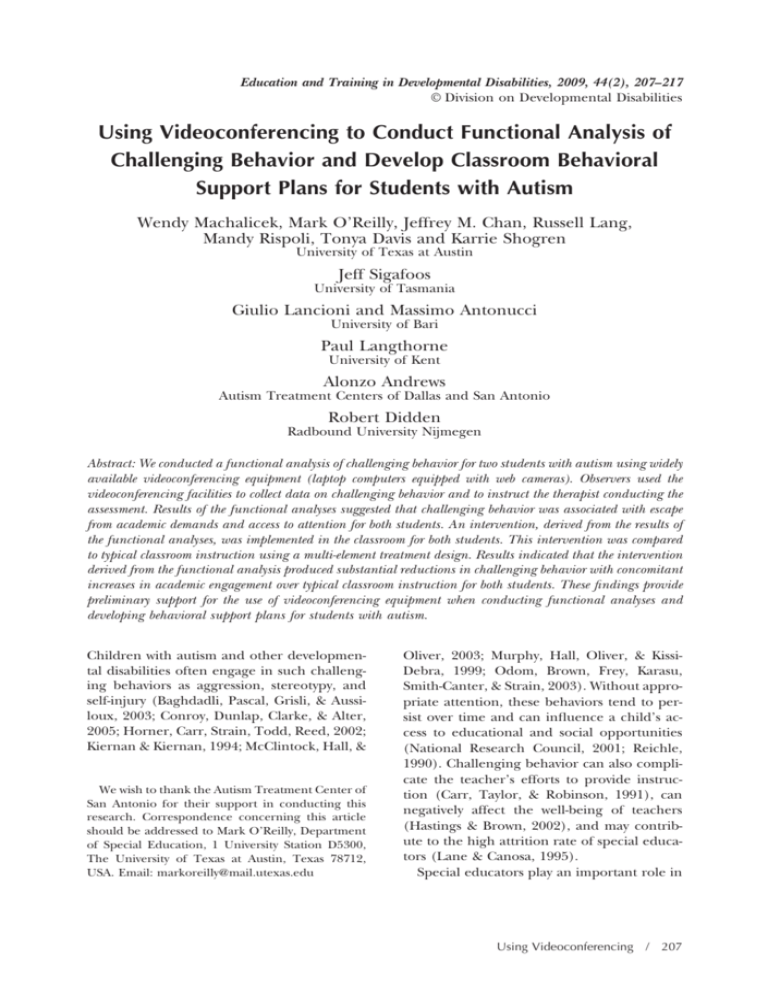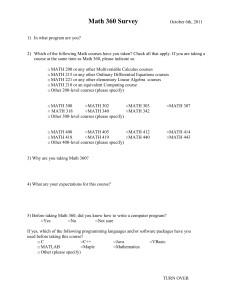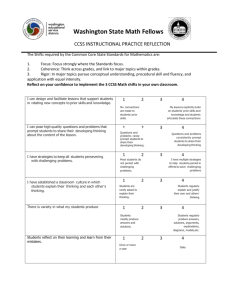Using Videoconferencing to Conduct Functional Analysis of
advertisement

Education and Training in Developmental Disabilities, 2009, 44(2), 207–217 © Division on Developmental Disabilities Using Videoconferencing to Conduct Functional Analysis of Challenging Behavior and Develop Classroom Behavioral Support Plans for Students with Autism Wendy Machalicek, Mark O’Reilly, Jeffrey M. Chan, Russell Lang, Mandy Rispoli, Tonya Davis and Karrie Shogren University of Texas at Austin Jeff Sigafoos University of Tasmania Giulio Lancioni and Massimo Antonucci University of Bari Paul Langthorne University of Kent Alonzo Andrews Autism Treatment Centers of Dallas and San Antonio Robert Didden Radbound University Nijmegen Abstract: We conducted a functional analysis of challenging behavior for two students with autism using widely available videoconferencing equipment (laptop computers equipped with web cameras). Observers used the videoconferencing facilities to collect data on challenging behavior and to instruct the therapist conducting the assessment. Results of the functional analyses suggested that challenging behavior was associated with escape from academic demands and access to attention for both students. An intervention, derived from the results of the functional analyses, was implemented in the classroom for both students. This intervention was compared to typical classroom instruction using a multi-element treatment design. Results indicated that the intervention derived from the functional analysis produced substantial reductions in challenging behavior with concomitant increases in academic engagement over typical classroom instruction for both students. These findings provide preliminary support for the use of videoconferencing equipment when conducting functional analyses and developing behavioral support plans for students with autism. Children with autism and other developmental disabilities often engage in such challenging behaviors as aggression, stereotypy, and self-injury (Baghdadli, Pascal, Grisli, & Aussiloux, 2003; Conroy, Dunlap, Clarke, & Alter, 2005; Horner, Carr, Strain, Todd, Reed, 2002; Kiernan & Kiernan, 1994; McClintock, Hall, & We wish to thank the Autism Treatment Center of San Antonio for their support in conducting this research. Correspondence concerning this article should be addressed to Mark O’Reilly, Department of Special Education, 1 University Station D5300, The University of Texas at Austin, Texas 78712, USA. Email: markoreilly@mail.utexas.edu Oliver, 2003; Murphy, Hall, Oliver, & KissiDebra, 1999; Odom, Brown, Frey, Karasu, Smith-Canter, & Strain, 2003). Without appropriate attention, these behaviors tend to persist over time and can influence a child’s access to educational and social opportunities (National Research Council, 2001; Reichle, 1990). Challenging behavior can also complicate the teacher’s efforts to provide instruction (Carr, Taylor, & Robinson, 1991), can negatively affect the well-being of teachers (Hastings & Brown, 2002), and may contribute to the high attrition rate of special educators (Lane & Canosa, 1995). Special educators play an important role in Using Videoconferencing / 207 the assessment and treatment of challenging behavior for students with severe disabilities. The Individuals with Disabilities Education Act of 1990 (IDEA) requires that a functional behavior assessment (FBA) be conducted prior to the development of a behavior support plan for students who engage in challenging behavior (IDEA, 1990; 1997; 2004). An FBA often consists of interviews with stakeholders, direct observation of the student, and functional analysis. This latter assessment protocol (i.e., functional analysis) involves directly manipulating social contexts to determine maintaining consequences and is usually reserved for students with the most severe topographies of challenging behavior (Sigafoos, Arthur, & O’Reilly, 2003). Functional analysis also requires a fairly high level of expertise on the part of staff to conduct it properly (Horner, Albin, Todd, & Sprague, 2006). Previous researchers have shown that teaching staff can learn to implement functional analysis procedures when training and direct supervision is provided (Durand, 1999; Iwata et al., 2000; Taylor, Hoch, & Weissman, 2005; Watson, Ray, Turner & Logan, 1999). This type of training requires the assistance of a specialist who is knowledgeable about evidence-based assessment and treatment strategies for challenging behavior. However, such specialists may not be readily available to a school district. The use of videoconferencing facilities may be one method by which schools could avail of such specialist support in conducting functional analyses. Videoconferencing as a means of conducting assessment and providing ongoing patient support is not new within the health care professions (Hilty, Luo, Morache, Marcelo, & Nesbitt, 2002). For example, videoconferencing has been used to conduct psychiatric assessments (Elford, 2000; Zarate, Weinstock, & Baer, 1997); to conduct psychotherapy and supervise trainee psychotherapists (Gammon, Sorlie, Bergvik, & Sorensen Hoifodt, 1998); and to provide follow up care for older adults following discharge from hospital (Tousignant, Boissy, Corriveau, & Moffet, 2006). Despite the emerging popularity of this technology in the health care professions there is an acute need for empirical research to demonstrate the effectiveness of assessments and interventions conducted in this 208 / manner (Glueckauf & Ketterson, 2004; Monnier, Knapp & Frueh, 2003). Very little research has been conducted on the use of videoconferencing within the field of education (Ludlow & Duff, 2002). To date, it appears that only one study has reported on the use of videoconferencing facilities to conduct a functional analysis with children with challenging behavior (Barretto, Wacker, Harding, Lee, & Berg 2006). These authors used a fiber-optic telemedicine network that was available through a medical center to instruct novice clinicians on how to conduct functional analyses. In the current study we attempted to extend the literature on the use of videoconferencing to conduct functional analyses in a number of ways. First, we wanted to examine the use of widely available videoconferencing equipment, such as laptop computers and basic web cameras, to conduct a functional analysis. The previous research by Barretto et al. (2006) made use of a telemedicine network located at a major medical facility. While many specialists and schools do not have access to telemedicine networks, most probably have access to less expensive videoconferencing equipment (e.g., laptop or desktop computers, Internet connection, and web cameras). Second, the findings of Barretto et al. suggest that future research should determine the efficacy of functional analysis results conducted via videoconferencing by examining the power of behavior support plans derived from such results. In this study we developed and evaluated interventions in the classrooms that were derived from the functional analyses conducted via videoconferencing. Method Participants and Settings Juanita was an 11-year-old Hispanic female and Jesse was a 7-year-old Caucasian female. Both girls were diagnosed with moderate intellectual disability and scored in the severe range of the Childhood Autism Rating Scale (Schopler, Reichler, DeVellis, & Daly, 1980). Neither girl had any spoken language. The functional analyses were conducted in an assessment room at the school the girls attended. The assessment room was equipped Education and Training in Developmental Disabilities-June 2009 with a table and several chairs. Observation, data collection, and supervision/coaching of the functional analysis procedures were conducted in a separate room at the same facility that will be referred to as the observation room. While observation and data collection could have been conducted in any locale where broadband facilities were available we decided to conduct the observations in the same facility. As a functional analysis had not been conducted using this technology before we wanted doctoral supervisors to be physically available in case there were unforeseen difficulties during the assessment process. Graduate students in special education with no experience implementing functional analyses served as implementers, conducting the functional analyses in the assessment room. Advanced doctoral students (board certified behavior analysts with extensive experience conducting functional analyses) served as supervisors and observers in the observation room. Both girls attended a special school for students with autism. The girls attended the same classroom. Five other students with similar disabilities and four staff (including one certified special education teacher) were typically present in the classroom. The interventions, derived from the results of the functional analysis, were conducted in the classroom. Target Behaviors Challenging behaviors were measured during the functional analysis and classroom intervention for both girls. For Juanita challenging behavior included, aggression (striking the therapist with an open hand or closed fist), property destruction (throwing or tearing instructional items), and self-injury (mild striking the side of her head with her hand). For Jesse challenging behavior included, dropping and lying on the floor, screaming (loud noises significantly above the conversational level), and self-injury (mild striking the side of her head with her hand). These challenging behaviors did not cause physical injury to the participants or the therapists during the study. Engagement was also measured during intervention in the classroom. Engagement was defined as being actively and appropri- ately involved with instructors or items (e.g., responding appropriately to teacher prompts and manipulating materials appropriately). Videoconferencing Equipment The functional analysis was conducted in the clinical assessment room while data collection, guidance, and supervision were conducted in the separate observation room via videoconferencing facilities. Videoconferencing was achieved using two 2.0 Ghz MacBook™ laptop computers with Mac OS X operating system, 2 external iSight™ cameras, iChat™ videoconferencing software, and a broadband Internet connection. The iSight™ camera has a 640X480-pixel video graphics array (VGA) and has auto exposure, auto focus, and video capture at 30 frames per second. Internal microphones of the iSight™ cameras were used to transmit sound and these cameras were placed on plastic standing mounts so that the experimenters could move them around as needed. One laptop computer with iSight™ camera connected via a single FireWire 400 (IEEE 1394a) cable was placed in the assessment room where the functional analysis was conducted. In the assessment room the computer was placed on a chair that was secured under a table. The camera was then placed on the table and adjusted to capture the area in which the assessment was to take place. The other laptop computer and iSight™ camera was placed in the observation room for data collection purposes. Data were transmitted via a wireless local area network (LAN) with Wi-Fi protected network access (WPN) maintained by the agency where the research was conducted. The confidentiality of data transmission was additionally secured through subscription to an Internet service providing a virtual private network (VPN) with 128-bit encryption. Phase I: Functional Analysis Procedure and Experimental Design A functional analysis was conducted to determine the contingencies maintaining challenging behavior for Juanita and Jesse. A series of three functional analysis conditions Using Videoconferencing / 209 were examined (i.e., attention, demand, and play). Individual sessions of each of these conditions were 5 min in length and challenging behavior was recorded using a 10 s partial interval procedure during sessions. The expert supervisors in the observation room instructed the implementer who was conducting the functional analysis via the videoconferencing equipment. The supervisors collected the data on challenging behavior, indicated which conditions were to be implemented (e.g., attention condition), when to change conditions (e.g., move from an attention condition to a play condition), and provided corrective feedback when errors in implementation occurred. Individual participant multi-element designs were used to demonstrate experimental control. In the attention condition the girls were free to engage with preferred materials, and the implementer ignored Juanita or Jesse unless challenging behavior occurred at which point the implementer delivered attention for approximately 10 s. This condition assessed whether challenging behavior was sensitive to positive reinforcement in the form of attention from others. In the demand condition the girls were engaged in a variety of instructional activities that were derived from their classroom curriculum (e.g., complying with verbal requests, identifying items from an array of pictures). Contingent upon challenging behavior the instructional items were removed for a minimum of 10 s and then immediately re-introduced once challenging behavior had ceased. This condition assessed whether challenging behavior was maintained by negative reinforcement in the form of escape from task demands. During the play condition the girls engaged in a variety of activities (e.g., playing with favorite toys) that they appeared to enjoy during observations prior to the assessment. The implementer interacted pleasantly every 10 s with the girls irrespective of their behavior during play. This condition served as a control condition for the other conditions as demands were absent and attention was freely available. An alone condition was not conducted as staff reported that challenging behavior did not occur when Juanita and Jesse were alone. 210 / Interobserver Agreement A second observer simultaneously yet independently observed 60% and 33% of functional analysis sessions for Juanita and Jesse respectively. These observations were also conducted via videoconferencing (the primary and secondary observers simultaneously viewed the functional analysis sessions on the same MacBook™). The number of agreements (occurrence and non-occurrence) for each 10 s interval during a 5 min session were divided by the total number of 10 s intervals for that session and multiplied by 100%. Interobserver agreement for Juanita and Jesse was 95% (range, 80% to 100%) and 90% (range, 83% to 97%), respectively. Results and Discussion The results of the functional analyses for Juanita and Jesse are presented in Figures 1 and 2 respectively. For Juanita, challenging behavior appeared to be maintained by access to attention (M ⫽ 28%) and escape from demands (M ⫽ 28%), with little challenging behavior occurring in the play condition (M ⫽ 5%). Challenging behavior for Jesse also seemed to be maintained by access to attention (M ⫽ 22%) and escape from academic demands (M ⫽ 79%) while challenging behavior was less frequent during the play condition (M ⫽ 8%). This first phase of the study demonstrated that it was possible to supervise, guide, and collect reliable data during a functional analysis conducted via videoconferencing facilities. The expert supervisors periodically communicated with the implementers via videoconferencing for procedural reasons (to indicate a change in condition), to resolve minor technological difficulties (the web camera required adjustment), and to provide constructive feedback. During each communicative exchange, the implementers received both auditory feedback via the microphone connection and visual feedback from the videoconferencing window on the computer screen. Similarly, the supervisors were able to hear and see the implementers acknowledge instruction or feedback. The most frequent reasons for communication were to indicate a change in functional analysis conditions, or to Education and Training in Developmental Disabilities-June 2009 Figure 1. Percentage of intervals with challenging behavior across attention, play and demand conditions for Juanita. correct an error in implementation. If the implementer failed to correctly implement the procedures of a condition, they were immediately interrupted by the supervisor and instructed to engage in the correct action. For instance, if the implementer failed to respond correctly to a target behavior during a demand condition, the target behavior was first pointed out to them by the supervisor (“Jane, she just hit her head.”), and then the supervisor indicated the correct response (“remove the task demand”). More infrequently, the implementers initiated communication with the supervisor to elicit feedback (How am I doing?). In these instances, the supervisor responded with a brief statement of praise. The quantity and quality of interactions during videoconferencing were similar to the type of interactions one would expect when supervising a functional analysis in person. In the next phase of the study we attempted to examine the efficacy of the results produced by these functional analyses. Ultimately, the applied efficacy of functional analysis results should be determined by their ability to dictate intervention strategies that reduce challenging behavior in real world settings. Phase 2: Classroom Interventions Procedure and Experimental Design In this phase of the experiment we examined the effects of a behavioral intervention, derived from the results of a functional analysis, on Juanita’s and Jesse’s challenging behavior during regular classroom routines. Results of the functional analyses indicated that challenging behavior was maintained by escape from academic demands and access to attention from others. The functional analysis results also demonstrated that challenging behavior was relatively low for both girls during the play condition. During play sessions attention was freely available and no demands were placed on the girls. Based on these results we hypothesized that an intervention incorporating high levels of attention with academic demands interspersed among preferred activi- Using Videoconferencing / 211 Figure 2. Percentage of intervals with challenging behavior across attention, play and demand conditions for Jesse. ties might reduce challenging behavior and increase academic engagement during classroom instruction (cf., O’Reilly, Sigafoos, Lancioni, Edrisinha, & Andrews, 2005). Sessions in this phase of the experiment were 30 min in length and were conducted in the girls’ classroom during normal classroom routines. In this phase we compared adapted instruction (based on the results of the functional analysis) versus typical classroom instruction. Both types of instruction (adapted versus typical) were conducted in a one-to-one format in the classroom. Observations of Juanita’s and Jesse’s behavior were conducted through a one-way mirror. Challenging behavior was measured using a 10 s partial interval procedure described in phase I of the study. Engagement was measured using a 10 s whole interval procedure. These measures were mutually exclusive (i.e., if challenging behavior was scored during a given interval then engagement could not be scored for that interval and vice versa). Sessions of adapted instruc- 212 / tion and typical instruction were implemented in a multi-element treatment design fashion in order to demonstrate experimental control. This phase of the study was conducted over an 8-week period for each of the girls. Typical Instruction During the typical classroom instruction condition instructional goals derived from each girl’s Individualized Education Plan (IEP) were taught using a one-to-one instructional format. Educational activities included complying with verbal requests, identifying items from an array of pictures, and motor tasks. Instructional trials were delivered approximately every 12 s using either a time delay or least to most prompt system. Challenging behavior was ignored and instruction was continued until the end of each session. Adapted Instruction The adapted instruction condition was similar to the typical instruction condition. Instruc- Education and Training in Developmental Disabilities-June 2009 Figure 3. Percentage of intervals with challenging behavior and engagement across typical instruction and adapted instruction conditions for Juanita. tional trials were again delivered every 12 s. Educational tasks and instructional strategies were the same as the typical instruction condition. However, between instructional trials the children were given access to preferred toys and received continuous positive attention. In effect, we replicated the play condition of the functional analysis (where challenging behavior was seen to be minimal) between teaching trials in the adapted instruction condition. Challenging behavior was ignored throughout these instructional sessions. Interobserver Agreement A second observer simultaneously yet independently observed 47% and 33% of instruction sessions for Juanita and Jesse respectively. The number of adapted and typical instructional sessions observed for reliability purposes was approximately equal for each girl. The number of agreements (occurrence and non-occurrence) for each 10 s interval during a 30 min session was divided by the total number of 10 s intervals for that session and mul- tiplied by 100%. Interobserver agreement for Juanita and Jesse was 89% (range, 77% to 95%) and 84% (range, 75% to 95%) respectively. Results and Discussion Results of the typical instruction versus adapted instruction conditions on levels of challenging behavior and engagement are presented in Figures 3 and 4 for Juanita and Jesse respectively. There were clear differences in performance for both girls under the typical instruction versus the adapted instruction conditions. Challenging behavior was lower and engagement was higher under the adapted instruction condition for Juanita and Jesse. For Juanita, challenging behavior was low under the adapted instruction (M ⫽ 13%) and high under typical instruction (M ⫽ 39%). Engagement was high under adapted instruction for Juanita (M ⫽ 70%) while engagement was low during typical instruction (M ⫽ 25%). These findings were similar for Jesse. Using Videoconferencing / 213 Figure 4. Percentage of intervals with challenging behavior and engagement across typical instruction and adapted instruction conditions for Jesse. Overall, results for phase II seem to indicate that an educational intervention, derived from the functional analysis, proved effective in terms of reducing challenging behavior and increasing academic engagement for both girls. These findings seem to demonstrate the efficacy of the prior functional analysis. Further, these findings in Phase II provide support for conducting a functional analysis via simple and widely available videoconferencing technology. Ultimately, the efficacy of a functional assessment should be defined by its ability to dictate effective interventions in applied settings. It seems that conducting functional assessments via videoconferencing may offer a viable strategy for clinicians and teachers. General Discussion In this study we demonstrated that widely available videoconferencing equipment could be used to provide supervision, guidance, and collect reliable functional analysis data and that these data can then be used to develop 214 / behavioral support plans to decrease challenging behavior and increase academic engagement in classrooms for students with autism. Expert supervisors were able to reliably collect data by watching the functional analysis in real time on a laptop computer screen. The supervisors were also able to both unobtrusively communicate the sequence and transition times of social conditions to the implementers and provide corrective feedback without being physically present in the assessment setting. These findings may have implications for future research on the use of videoconferencing technology to support assessment and intervention for students with autism and other severe disabilities. In terms of the applied implications, this preliminary demonstration suggests that videoconferencing might provide teachers with a means of gaining support from specialists in a way that does not necessarily require the specialist to be physically present at the school. This could be an advantage in terms of financial cost and time commitment, as it re- Education and Training in Developmental Disabilities-June 2009 duces the need for travel. And, as mentioned in the Introduction, conducting pre-intervention functional behavioral assessment is considered best practice and is required under IDEA. For students with severe challenging behavior, functional analysis can be an important component of the FBA process (Sigafoos et al., 2003). However, teachers have reported difficulty implementing this type of assessment (Applegate, Matson, & Cherry, 1999; Ayres, Meyer, Erevelles, & Park-Lee, 1994), and state-developed FBA standards tend to provide more limited information and resources on functional analysis methodology in comparison to other FBA methods such as informant interviews and direct observations (Weber, Killu, Derby, & Barretto, 2005). The technology reported in this paper has the potential to address some of the difficulties teachers face in implementing functional analysis methodology in educational settings and could enable educators to undertake the complex assessments that are required by legislation. As shown in this and other research, functional analysis can play a critical role in the development of effective, function-based interventions for reducing problem behavior and increasing appropriate behavior in students with severe disabilities. Further, given the emphasis in the functional behavior assessment literature on integrating information from multiple sources and methodologies (e.g., indirect assessments, direct observations, functional analysis) in developing a function-based intervention, it seems critical to develop strategies to support the use of functional analysis procedures, in addition to informant and observational methodologies, in educational contexts. An important area for future research would be to also evaluate whether this same technological approach would enable teachers to implement evidence-based practice in other areas of education for students with autism and other developmental disabilities, such as assessment and instruction of communication, social skills, and other adaptive behaviors. Videoconferencing might also facilitate the supervision of pre-service teachers during their practicum experiences. University instructors are typically in charge of supervising large numbers of pre-service teachers, which often requires travel to numerous practicum sites and this can limit the number of on-site supervision sessions available to each pre-service teacher. For the purposes of learning to conduct such complex assessments as functional analysis, immediate feedback is preferred, but not always available for pre-service teachers. The use of videoconferencing to supervise teachers may facilitate the immediate feedback called for by researchers (cf., Lang & Fox, 2003) and could facilitate lengthier and more frequent supervision. There are a number of limitations with the current research. First, this study was conducted with two participants thus limiting the generalizability of the findings. Future research should attempt to replicate this methodology with additional students. The implementers conducting the assessment had some prior exposure to functional analysis procedures during university classes. This exposure may have increased the likelihood of their successful implementation of the procedures. Ultimately, the applied veracity of this method can only be demonstrated by showing that it can positively affect the skills of practitioners such as teachers. Future research should directly examine the use of such technologies as a means to train such skills to teachers. In the present study videoconferencing was conducted within the same facility. Future research should replicate this methodology over greater physical distances. For example, wider access to specialists would arise if the approach proved workable when the specialist is based in a different state or country than practitioners. References Applegate, H., Matson, J., & Cherry, K. (1999). An evaluation of functional variables affecting severe problem behaviors in adults with mental retardation by using the Questions about Behavioral Function Scale (QBAF). Research in Developmental Disabilities, 20, 229 –237. Ayres, B., Meyer, L., Erevelles, N., & Park-Lee, S. (1994). Easy for you to say: Teacher perspectives on implementing most promising practices. Journal of the Association for Persons with Severe Handicaps, 19, 84 –93. Baghdadli, A., Pascal, C., Grisli, S., & Aussiloux, C. (2003). Risk factors for self-injurious behaviours among 222 young children with autistic disorders. Using Videoconferencing / 215 Journal of Intellectual Disability Research, 47, 622– 627. Barretto, A., Wacker, D., Harding, J., Lee, J., & Berg, W. (2006). Using telemedicine to conduct behavioral assessments. Journal of Applied Behavior Analysis, 39, 333–340. Carr, E., Taylor, J., & Robinson, S. (1991). The effects of severe behavior problems in children on the teaching behavior of adults. Journal of Applied Behavior Analysis, 24, 525–535. Conroy, M., Dunlap, G., Clarke, S., & Alter, P. (2005). A descriptive analysis of positive behavior intervention research with young children with challenging behavior. Topics in Early Childhood Special Education, 25, 157–166. Durand, M. (1999). Functional communication training using assistive devices: Recruiting natural communities of reinforcement. Journal of Applied Behavior Analysis, 32, 247–267. Elford, R. (2000). A randomized controlled trial of child psychiatric assessments conducted using videoconferencing. Journal of Telemedicine and Telecare, 6, 73– 82. Gammon, D., Sorlie, T., Bergvik, S., & Sorensen Hoifodt, T. (1998). Psychotherapy supervision conducted via videoconferencing: A qualitative study of users’ experiences. Nordic Journal of Psychiatry, 52, 411– 421. Glueckauf, R., & Ketterson, T. (2004). Telehealth interventions for individuals with chronic illness: Research review and implications for practice. Professional Psychology: Research and Practice, 35, 615– 627. Hastings, R., & Brown, T. (2002). Coping strategies and the impact of challenging behaviors on special educators’ burnout. Mental Retardation, 40, 148 –156. Hilty, D., Luo, J., Morache, C., Marcelo, D., & Nesbitt, T. (2002). Telepsychiatry an overview for psychiatrists. CNS Drugs, 16, 527–548. Horner, R., Albin, R., Todd, A., & Sprague, J. (2006). Positive behavior support for individuals with severe disabilities. In M. Snell & F. Brown, Instruction of students with severe disabilities (6th ed.) (pp. 206 –250). Columbus Ohio: Pearson, Merrill, Prentice Hall. Horner, R., Carr, E., Strain, P., Todd, A., & Reed, H. (2002). Problem behavior interventions for young children with autism: A research synthesis. Journal of Autism and Developmental Disorders, 32, 423– 446. Iwata, B., Wallace, M., Kahng, S., Lindberg, J., Roscoe, E., Conners, J., et al. (2000). Skill acquisition in the implementation of functional analysis methodology. Journal of Applied Behavior Analysis, 33, 181–194. Kiernan, C., & Kiernan, D. (1994). Challenging be- 216 / haviour in schools for pupils with severe learning difficulties. Mental Handicap Research, 7, 177–201. Lane, G., & Canosa, R. (1995). A mentoring program for beginning and veteran teachers of students with severe disabilities. Teacher Education and Special Education, 18, 234 –239. Lang, M., & Fox, L. (2003). Breaking with tradition: Providing effective professional development for instructional personnel supporting students with severe disabilities. Teacher Education and Special Education, 26, 17–26. Ludlow, B., & Duff, M. (2002). Live broadcasting online: Interactive training for rural special educators. Rural Special Education Quarterly, 21, 26 –30. McClintock, K., Hall, S., & Oliver, C. (2003). Risk markers associated with challenging behaviors in people with intellectual disabilities: A meta-analytic study. Journal of Intellectual Disability Research, 47, 405– 416. Monnier, J., Knapp, R., & Frueh, B. (2003). Recent advances in telepsychiatry: An updated review. Psychiatric Services, 54, 1604 –1609. Murpy, G., Hall, S., Oliver, C., & Kissi-Debra, R. (1999). Identification of early self-injurious behavior in young children with intellectual disability. Journal of Intellectual Disability Research, 43, 149 –163. National Research Council. (2001). Educating Children with Autism. Committee on Educational Interventions for Children with Autism. C. Lord & J. P. McGee, (Eds.), Division of Behavioral and Social Sciences and Education. Washington, DC: National Academy Press. Odom, S., Brown, W., Frey, T., Karasu, N., SmithCanter, L., & Strain, P. (2003). Evidence based practice for young children with autism: Contributions for single-subject design research. Focus on Autism and Other Developmental Disabilities, 10, 166 –175. O’Reilly, M., Sigafoos, J., Lancioni, G., Edrisinha, C., & Andrews, A. (2005). An examination of the effects of a classroom activity schedule on levels of self-injury and engagement for a child with severe autism. Journal of Autism and Developmental Disorders, 35, 305–311. Reichle, J. (1990). National working conference on positive approaches to the management of excess behavior: Final report and recommendations. Minneapolis, MN: Institute on Community Integration, University of Minnesota. Schopler, E., Reichler, R., DeVellis, R., & Daly, K. (1980). Toward objective classification of childhood autism: Childhood autism rating scale (CARS). Journal of Autism and Developmental Disorders, 10, 91–103. Sigafoos, J., Arthur, M., & O’Reilly, M. (2003). Challenging behavior and developmental disability. London: Whurr Publishers. Education and Training in Developmental Disabilities-June 2009 Taylor, B., Hoch, H., & Weissman, M. (2005). The analysis and treatment of vocal stereotypy in a child with autism. Behavioral Interventions, 20, 239 –253. The Individuals with Disabilities Education Improvement Act of 2004, Pub. L. No. 108 – 446, § 101, 118 Stat. 2647 (2004). The Individuals with Disabilities Act Amendments of 1997, Pub. L. No. 17–105, § 101, 111 Stat. 37 (1997). The Individuals with Disabilities Education Act of 1990, 20 U.S.C. §§ 1400 et seq. Tousignant, M., Boissy, P., Corriveau, H., & Moffet, H. (2006). In home telerehabilitation for older adults after discharge from an acute hospital or rehabilitation unit: A proof-of-concept study and costs estimation. Disability and Rehabilitation: Assistive Technology, 1, 209 –216. Watson, T., Ray, K., Sterling Turner, H., & Logan, P. (1999). Teacher-implemented functional analysis and treatment: A method for linking assessment to intervention. School Psychology Review, 28, 292– 302. Weber, K. P., Killu, K., Derby, K. M., & Barretto, A. (2005). The status of functional behavior assessment (FBA): Adherence to standard practice in FBA methodology. Psychology in the Schools, 42, 437–744. Zarate, C., Weinstock, L., Baer, L. (1997). Applicability of telemedicine for assessing patients with schizophrenia: Acceptance and reliability. The Journal of Clinical Psychiatry, 58, 22–25. Received: 3 November 2007 Initial Acceptance: 3 January 2008 Final Acceptance: 11 March 2008 Using Videoconferencing / 217







